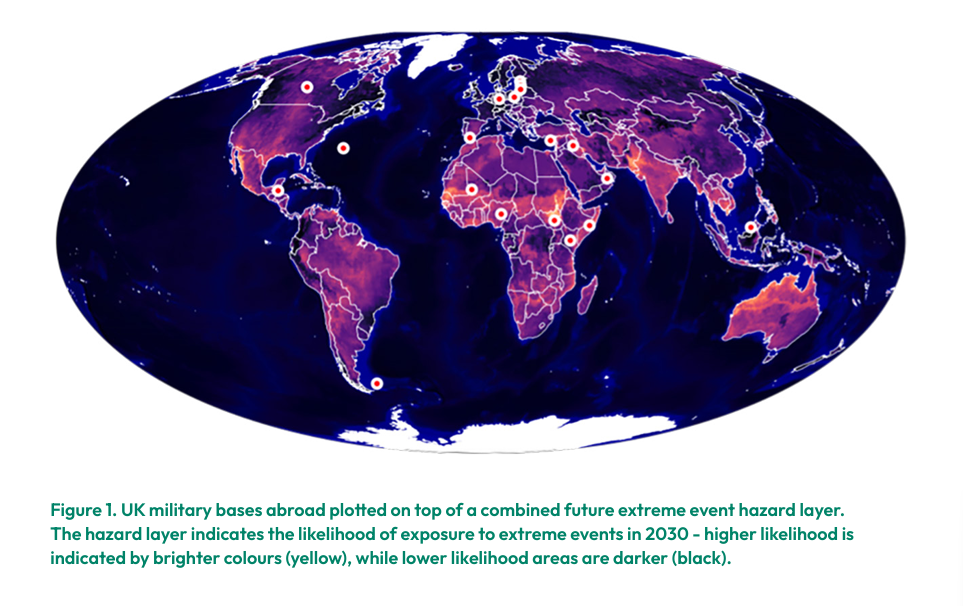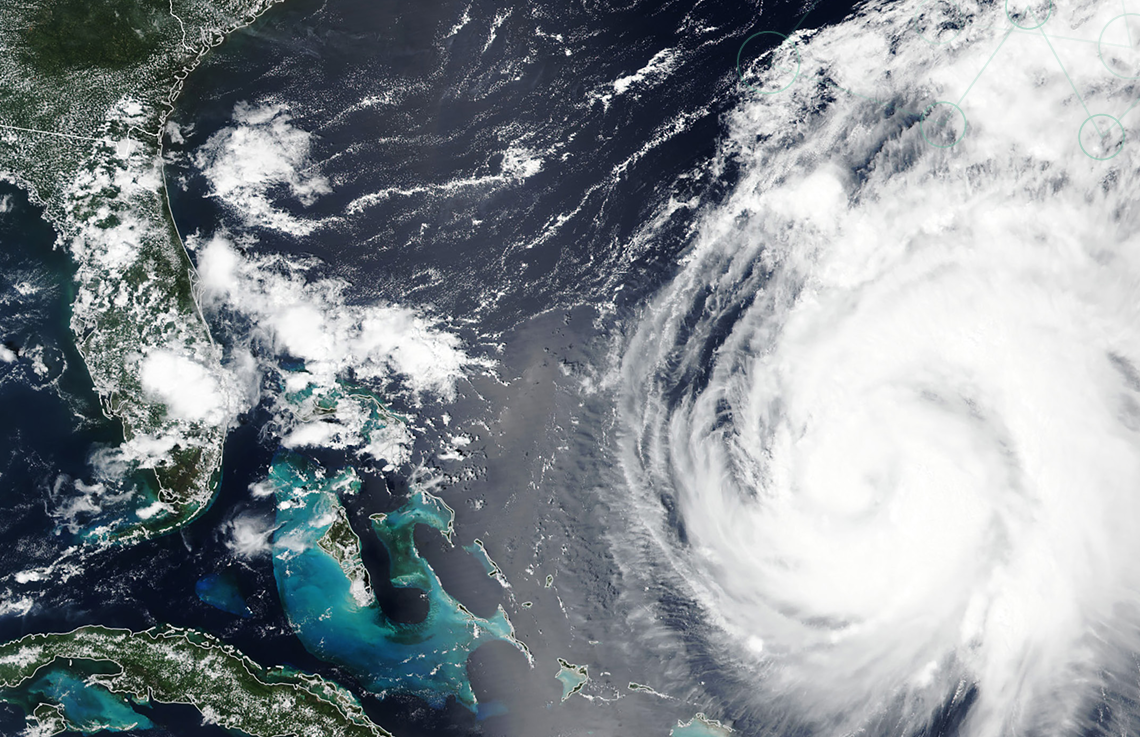Blog
What impact will climate change have on UK defence and military operations?

The world is currently facing an unprecedented convergence of climate change impacts, resource scarcity and geopolitical tensions. These are not future problems – the impacts of climate change are already outpacing predictions, with a significant increase in the frequency and severity of extreme climate events over the past decade. Global mean temperatures have already reached 1.3°C above pre-industrial levels, while 2024 was the hottest year ever and the first year to break 1.5°C.
In the UK, rising global temperatures translate to heavier rainfall, flooding, heatwaves, and storm surges along the coast. This leads to impacts on military assets, operations, supply chains, and personnel that are vulnerable to such extreme weather. Simultaneously, armed forces are increasingly expected to support responses to climate-related disasters and humanitarian crises, putting further stress on resources and capacity.
About the Author
Dr Jesse Abrams is a climate systems expert and an Impact Fellow in the Green Futures Solutions team. He has co-authored several landmark reports on climate risk and national security, including the Planetary Solvency report and the Security Blind Spot.
In this article, he reflects on the current state of UK defence thinking on climate change, focusing on the threat that extreme events associated with climate change present – and highlighting the underestimation of its impacts.
Current understanding of the impact of climate change on UK Defence and National Security
The UK defence and national security community broadly recognise climate change as a dominant global trend and risk multiplier. In general, there is an awareness of the threats to UK military infrastructure, personnel, and operations both at home and abroad, with a growing recognition of the direct impacts of extreme weather on military assets and capabilities. There is also recognition of climate as a stress multiplier and the potential role it will play in geopolitics, acknowledging how climate impacts can exacerbate existing tensions, create new security challenges, and is a risk to vulnerable populations.
We have already seen a shift in the military’s role, and anticipate a continued increase, towards the need for military assistance and stability operations in response to climate-related crises and disasters. These issues are broadly understood in the MOD’s current approach to climate security; however, it does not fully capture the urgency and complexity of the challenge.
Impacts on domestic military infrastructure, personnel, and operations
There is an increasing risk from extreme weather hazards to UK-based military infrastructure and assets. Coastal navy bases are vulnerable to rising sea levels and storm surges while inland army bases, and air stations are at risk from more frequent occurrence and increased severity of river flooding.
More frequent and severe heatwaves also threaten military assets, operations and personnel. In July 2022, the runways warped and melted under extreme heat during the record-breaking heatwave which saw temperatures exceed 40°C for the first time in the UK causing flights to be disrupted. In the summer of 2024, a Guardsman passed out during rehearsal exercises.
Additionally, prolonged heat puts stress on temperature-sensitive equipment such as aircraft, vehicles and radar systems and increases cooling costs for buildings and information technology systems. Extreme weather also has the potential to disrupt military operations and increase costs thereof.
Heavy rainfall and flooding impede mobility, destroys vehicles and equipment, and disrupts supply routes. During the floods in Somerset in 2014, the Army had to deploy specialist vehicles to navigate flooded roads and rescue stranded residents.93 Extreme weather also threatens the civilian infrastructure upon which the military relies, such as electricity grids, transportation networks and communication systems.
Further – as we saw during the 2022 heatwave – high temperatures cause rail tracks to buckle and overhead power lines to sag, leading to speed restrictions and service disruptions that can delay transportation. Compounding these risks, much of the UK military’s infrastructure and building stock is ageing and was not designed with climate resilience in mind. Older buildings and infrastructure are more susceptible to weather damage, and are also costly to retrofit. According to the National Audit Office, in 2021 40% of the Defence Estate was over 50 years old, and the maintenance backlog has risen above £4 billion. These make military infrastructures vulnerable to disruption and degradation from extreme weather.
Impacts on military infrastructure, personnel, and operations abroad
While the direct impacts of extreme weather on UK domestic military infrastructure and operations are very important, the consequences of climate change overseas could prove to be even more disruptive to UK defence and security interests.
The UK has a global military footprint, with bases, training areas, and operational deployments in several regions highly exposed to climate-related risks, including the Middle East, South Asia, and the Caribbean. The UK has a significant military presence in the Middle East, which is a region that is particularly vulnerable to climate change impacts.
RAF Akrotiri, in Cyprus, serves as a key operational hub in the region and plays an important role in the operation of the vital SIGINT (Signals Intelligence) radar in the Troodos Mountains. This facility is highly vulnerable to climate-related events with an increasing risk of severe weather and major risk stemming from rising sea levels. This could have serious implications for UK intelligence gathering and strategic operations in the region.
Elsewhere, the operational headquarters of the RAF in the Persian Gulf is in Qatar and other facilities in the UAE and Oman face challenges from the increasing occurrence of extreme heat and potential water scarcity issues.
Difficult conditions in many operational theatres storm damage can impact access of personnel. accelerate wear and tear on equipment, requiring more frequent maintenance and replacement. Heatwaves can reduce aircraft range and effectiveness by limiting their payloads and flight times, rough seas and high winds can interfere with naval manoeuvres and flight operations from carriers, and physical changes to the environment such flooding or storm damage can impact access of personnel.
The UK military had first-hand experience of these challenges during relief operations after Hurricanes Irma and Maria in the Caribbean in 2017. The widespread flooding, debris, and power outages affected ground movements and communications, while the hot and humid conditions strained personnel.
Shifting geopolitics and climate change as a stress multiplier
Climate change has the potential to reshape geopolitics and alter the UK’s strategic interests – affecting different regions in distinct ways. Climate change exacerbates existing issues in many contexts – driving conflict, the involuntary displacement of people, resource scarcity and other human security issues.
Climate change may drive competition for control and access to resources to new regions. In the Arctic, retreating sea ice is opening new shipping routes and intensifying competition for resources. The UK, as a “near-Arctic state,” has strategic interests that could be affected by these changes. Extreme weather events, unpredictable ice conditions, and thawing permafrost could impact potential UK operations or partnerships in the region.
Regions already affected by conflict and crisis are more likely to be overwhelmed by the effects of climate change. The Middle East and North Africa, already marked by political tensions and resource scarcity, face increased risks of conflict and displacement of populations due to climate change.
Severe droughts could lead to crop failures and water shortages, potentially triggering mass migration, urban unrest, and heightened competition for limited resources. The Syrian civil war, while complex in its origins, was partly fuelled by such climate-induced stresses. Large scale shifts in temperature and precipitation patterns may fuel existing tensions. In South Asia, changing monsoon patterns and glacial melt in the Himalayas threaten devastating floods and long-term water scarcity.
This may intensify long-standing tensions between nuclear-armed India and Pakistan over shared river systems. The region’s vulnerability to climate change and its potential impact on stability and security was highlighted by the 2022 record flooding in Pakistan, which affected over 33 million people.
The underestimation of climate risks
The previous section highlighted the landscape of risks due to climate extremes that the UK defence establishment acknowledges in some form. However, both the UK and international allies defence planning, have significantly underestimated the scale, pace, and complexity of the climate security challenge.
Current thinking often views climate change as a long-term, gradual, first-order issue. However, the reality is that climate change is already a key driver of insecurity, with impacts being felt now rather than in some distant future. The defence sector has yet to fully grasp how drastically conditions are likely to change and how quickly these changes may occur. The manifestation of impacts from climate change are outpacing scientists’ predictions in both frequency and intensity.
Furthermore, current assessments often fail to account for the potential of non-linear change (such as tipping points), cascading effects, and compound risks that could rapidly accelerate the pace of change and magnify its impacts. These threats are escalating with an increasing chance of triggering tipping points this century. This has led to a significant underestimation of the threat that climate change poses.
In our recent report, the Security Blind Spot, we demonstrate how tipping points in the Atlantic Ocean circulation, specifically the collapse of the subpolar gyre, could cause shocks to the UK food, energy and economic systems. We show that there is a non-negligible chance of this tipping point being triggered as soon as 2040 and a 45% of it being triggered this century.
The UK is particularly vulnerable to tipping points in the Atlantic Ocean due to its geographic location and would be amongst the countries worst affected by the North Atlantic Subpolar Gyre (SPG) collapse. However, the UK is not prepared for this event and tipping points (as well as other climate change threats) do not even appear on the national risk register.

One of the more significant areas of underestimation is the potential for simultaneous, compounding events such as a synchronous failure of multiple global breadbaskets due to extreme weather. This could trigger widespread food insecurity, social unrest, and migration pressures, straining military resources and further complicating existing geopolitical tensions. Soaring food prices due to extreme weather events that resulted in droughts and harvest losses in major wheat-producing regions such as China and Eastern Europe are believed to be precipitating conditions for social unrest that culminated in the series of protests and uprisings known as the Arab Spring.
The timescale of climate impacts is another area where current thinking falls short. While some effects are gradual, others can manifest rapidly, particularly when tipping points are crossed. The defence sector’s long-term planning horizons, while necessary for major acquisitions and infrastructure projects, may inadvertently lead to a false sense of having time to adapt gradually to climate change. Furthermore, the MOD’s current approach often treats climate change as a distinct, somewhat isolated issue. However, its impacts are likely to intersect with and exacerbate other security challenges in complex ways.

For instance, climate-induced resource scarcity could fuel conflicts in strategically important regions, creating new demands on UK military resources and capabilities. An illustrative example are the unprecedented heat waves in the Sahel region which have intensified existing challenges, exacerbating intercommunal tensions, heightening competition for scarce resources, and potentially fuelling radicalisation.
The frequency of climate-related military deployments, which has surged dramatically, illustrates this. In 2024 armed forces from 62 nations, including major powers, including the US, China and Germany, were mobilised to address climate-induced crises. This period saw 250 deployments for climate-related military operations.
Climate change also has tangible impacts on human security and prosperity, beyond those of purely national defence and security. For example, recent studies suggest that extreme weather events may have contributed up to one-third of the rises in food prices that occurred in the UK between 2022 and 2023. The impacts of this had a consequential impact on the outcome of the 2024 UK elections.
The rapid acceleration of climate impacts presents adaptation challenges for the defence sector and leads to an ever-increasing gap between the evolving threat landscape and current preparedness levels.
This does not even start to consider the increasing risk of Earth system tipping points, such as major ice sheet collapse or ocean circulation shutdown. Such events would abruptly alter the face of the planet irrevocably with profound implications for global security. The potential for these tipping points to cascade, creating compound effects that amplify and accelerate climate impacts, represents a critical blind spot in current defence planning and risk assessment frameworks.
Necessary Changes to Defence Strategy: A Strategic Imperative
Given the underestimation of climate impacts, a fundamental reassessment of UK defence strategy is urgently needed. This should strive for a comprehensive view of the threats to UK security from the climate crisis, supplementing and filling the gap between the current Climate Change Risk Assessment and National Security Risk Assessment processes.
In addition to the initiation of the national security risk assessment of climate change, to address these urgent challenges and strategic imperatives the following changes to defence strategy are necessary:
What Next?
A coordinated MOD strategy that includes adaptation investments, enhancing institutional resilience, and a comprehensive risk evaluation is necessary to robustly address climate change related issues.
Failure to prioritise climate resilience may lead to operational disruptions, widening capacity gaps, and monetary losses. It will cost billions of pounds to climate-proof military infrastructure, but the cost of inaction will be far greater.
Let's work together
To work with Jesse Abrams and other leading climate scientists from the University of Exeter, contact the Green Futures Solutions team.
This essay was originally published in the University of Exeter’s Defence, Security and Resilience Compendium in February 2025.
Related
Exeter Innovation
We are the trusted partner in transformative innovation, empowering organisations across the globe to make ecologically responsible decisions – for today and for future generations.







